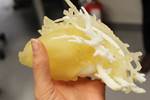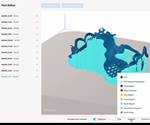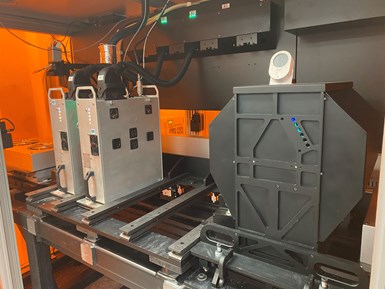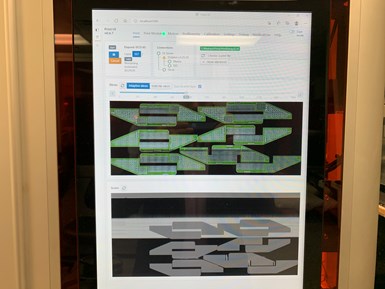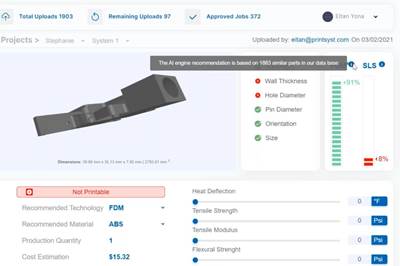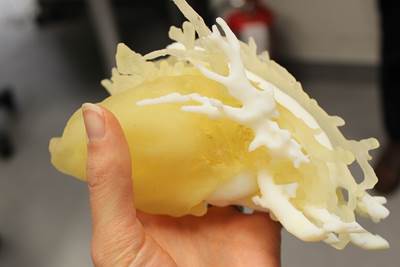According to Inkbit co-founder Javier Ramos, the materials typically available for inkjet 3D printing have held the process back from being used in production of end-use parts. But the company’s Vista inkjet printer is designed to expand the range of materials, and therefore the range of applications for inkjet printing.
Inkjet 3D printing has a lot of potential for production applications. Its scalability has been proven by industrial 2D inkjet printing, and it’s natively multi-material. But thus far, it has been limited to prototyping and other non-end-use applications. This is primarily due to the limitations affecting materials. Inkjet traditionally works best with materials such as acrylates because the curing reaction is easy to control — these materials cure when a light source is on, and stop curing when the light is off. In inkjet printing, this ensures that runaway polymerization doesn’t cure material onto the roller or flattener that ensures that every layer is flat and level, jamming up the machine. However, acrylates aren’t suitable for most end-use applications. They tend to be weak and brittle, and they break down when exposed to light. Polymers such as epoxy have better properties for end-use parts, but they’re challenging to print via inkjet because of their continuous curing properties — the curing process is initiated in the presence of light, but they keep curing even when the light is off.
Inkbit, a Medford, Massachusetts based startup, has found that by adding machine vision to the printing process, it’s possible to inkjet 3D print a wider range of materials. The company was founded in 2017 with the intention of making a more reliable inkjet 3D printer. In pursuit of this goal, the team decided to add a vision system to the machine. As they started working with it, they realized they could use the vision system to eliminate the need for a mechanical roller or flattener. Davide Marini, CEO of Inkbit, says that this was the first step in freeing inkjet printing to work with continuously curing materials.
The Vista’s build surface passes beneath the stationary print modules, which deposit the material, then beneath the curing and scanning heads and onto a cooling station before the process is repeated. The machine’s current build rate (measured in the z-axis) is 9 mm/hour, with a target of 18 mm/hr, meaning it can print a part the size of a person’s palm at a rate of about 5 per hour right now, with a target rate of 10 per hour.
Vision for Production
Earlier this year, Inkbit launched the Vista, an inkjet printer with a closed-loop feedback control system that is designed to enable printing of a wider range of materials. It has room for four print modules, enabling multi-material printing with three different materials and a support material. The build surface passes beneath the stationary print modules, where a layer of material is deposited. Then it passes below the curing and scanning heads and onto a cooling station before the process is repeated.
The machine is designed for production. The build rate, which is measured in the Z-axis, is currently 9 mm/hour, with a target of 18 mm/hour when systems begin to be installed at production sites. This means that it can print a part the size of a person’s palm at a rate of about 5 per hour right now, with a target rate of 10 per hour.
The vision system is key to its ability to print high-performance materials, enabling a non-contact printing process that doesn’t require the use of a roller or flattener. The vision system, which includes a scanner with lasers, optics and high-speed cameras, was developed to work at the speed of the printer, so it doesn’t slow the process down. Once the machine has scanned a layer, it produces a topographical image. The system then uses the data to adjust the print to compensate subsequent layers for any areas that aren’t flat, ensuring that the final part has the correct geometry.
Another consideration with inkjet materials is viscosity. Traditional inkjet 3D printing works best with low-viscosity materials because they’re easier to deposit than higher-viscosity materials. One way inkjet printers, including the Vista, reduce the viscosity of materials as they’re printed is through the use of a heated printhead. “We operate at temperatures that are higher than ambient temperatures,” says Rich Woudenberg, principal inkjet engineer. “That allows us to expand our range of properties.”
The Vista’s vision system scans every layer of a part as its printed, and creates a topographical map of each layer. The machine uses this data to adjust subsequent layers to ensure that the final part has the correct geometry without the use of a mechanical roller or flattener.
Adding AI
Another challenge with inkjet 3D printing more viscous materials is that it’s difficult to predict how these materials will flow as they’re jetted, and therefore difficult to control how they cure. Artificial intelligence can help address these challenges by using the scan data to learn and predict how these materials will flow as they cure, and adjust the print or part design to account for these systematic errors.
Within a part, AI can use the scans of each layer from the vision system to learn how the material is flowing. It can then adjust subsequent layers to compensate for the material’s behavior. As the machine builds up the part, it learns and improves the printing process.
Eventually, the AI capabilities will be able to pull from a database of scans from previous prints to modify part designs. If example, is a user is trying to print a square but the corners come out rounded, the system might know from past experience to add material to the corners to ensure the final geometry is straight. 3D printing systems often do this on a general level when establishing print parameters for a material, but AI will eventually enable Inkbit to automatically determine these geometry-specific parameters based on scan data from previous prints.
Producing Materials
This pinch valve was printed in one part using two different materials—the tubing is elastomeric thiol-ene, while the rest of the part is chemical-resistant epoxy. These materials aren’t used in traditional inkjet printers because they continue to cure even after the light source is off, making the layers difficult to flatten. The Vista’s non-contact printing process makes it possible to inkjet these materials.
Because it’s applying new materials to the inkjet process, Inkbit is producing its own materials. Currently, it offers a chemical-resistant epoxy, a thiol-ene elastomer and a wax support material. It’s working on expanding its material portfolio. “The long term goal is to open up material families that aren't really being 3D printed,” says Scott Twiddy, senior materials scientist. These new materials will have more functionality than the acrylates that are traditionally used in inkjet 3D printing. One way Inkbit hopes to do this is to develop a way to jet low-viscosity/short-chain molecules, and then create reactions that will result in long-chain molecules with the desired material properties. “We're working on chemistry tricks to basically build a long chain as we go,” Marini explains.
Twiddy says that in order to be able to print a material with inkjet, it needs a catalyst (a substance that increases the rate of a reaction without being consumed) that will work with the process. Because 20 to 50% of the resin is recirculated, it’s important to ensure that the material’s viscosity remains consistent over a period of time, but then reacts and solidifies on demand when it’s printed. “That's a huge challenge,” he says. He notes that while there are promising new catalysts that are being developed and researched, they aren’t ready for industrial use. The two materials the company has currently developed (epoxy and elastomer) have been around for decades, so there’s a lot of understanding of how to use them and they’re already being produced at scale. “The biggest challenge probably is transitioning this more experimental stuff from academia into industry, and filling in the gaps where people maybe aren't looking at inkjet,” he adds.
Epoxy and thiol-ene have better properties for end-use parts, but they’re challenging to print via inkjet because the curing process doesn’t stop when the UV light is off and the materials can jam mechanical flatteners. The Inkbit Vista uses a non-contact printing process that replaces mechanical flatteners with a machine vision system, allowing the printing of continuously curing materials.
This means that not only will the company have to develop new materials, it will also have to figure out how to produce them at scale. “If you start working with new chemistries, you might be able to make them easily in the lab to, you know, 100 liters,” says Javier Ramos, cofounder and director of hardware. “But then we need to also create a supply chain and a manufacturing process.” Inkbit hopes to draw on the experience of some of its investors with experience producing materials, and is also open to collaborating with customers on material development.
The company is currently working with UV-curable materials and phase-change materials, which are jetted out in liquid form and then solidify, like the wax support material. But it’s not ruling out the possibility of working with other curing methods, and eventually combining materials with different curing methods into a single part.
End Users
About a dozen manufacturers so far see this as a solution for their own scale production of plastic components, and are working with Inkbit to ensure that the materials and machine will meet their application’s needs. But because of the level of collaboration required, it’s taking time to ramp up to production levels. The technology is currently in the prototyping phase with several customers, and Inkbit expects customers in low-regulation industries to be scaled up in the next few years, while customers in higher-regulation industries will take longer. It’s targeting a variety of industries, including packaging automation, laboratory diagnostic equipment and logistics. The company also has a partnership with the Air Force to put systems at three different bases to start.
The company’s ultimate goal is for the machine to produce final products through the coordinated use of multiple materials, not just parts. This will require integrated postprocessing, such as support removal, and perhaps even design software focused on this possibility.
Related Content
3D Printing with Plastic Pellets – What You Need to Know
A few 3D printers today are capable of working directly with resin pellets for feedstock. That brings extreme flexibility in material options, but also requires greater knowledge of how to best process any given resin. Here’s how FGF machine maker JuggerBot 3D addresses both the printing technology and the process know-how.
Read MoreCasting With Complexity: How Casting Plus 3D Printing Combine the Strengths of Both
Aristo Cast is advancing a mode of part production in which casting makes the part, but 3D printing enables the geometry.
Read MoreHow Siemens Energy Applies Additive Manufacturing for Power Generation and More
At an applications center in Orlando, Florida, a small team of AM specialists is spanning industries by 3D printing parts to support both Siemens Energy power generation systems and external customers.
Read MoreWhat Does Additive Manufacturing Readiness Look Like?
The promise of distributed manufacturing is alluring, but to get there AM first needs to master scale production. GKN Additive’s Michigan facility illustrates what the journey might look like.
Read MoreRead Next
PrintSyst Automates AM Decision Making with AI (Includes Video)
The startup’s cloud-based artificial intelligence tool is designed to help companies adopting additive manufacturing make fast, easy decisions about what and how to 3D print.
Read MoreWhat Is Material Jetting 3D Printing?
Recent advances in materials processing capabilities have renewed interest in material jetting, the additive process that allows 3D objects to be built by placing different combinations of material drop-by-drop.
Read MoreAI-Driven "Operating System" Makes Data Count
AI assistance could help additive manufacturing operations link engineering and design data to what is really happening on the factory floor.
Read More



